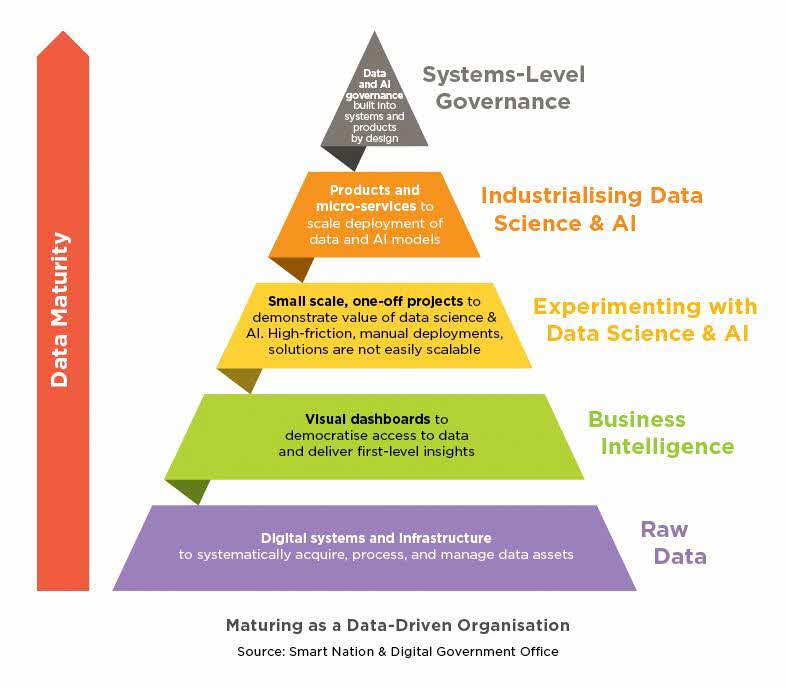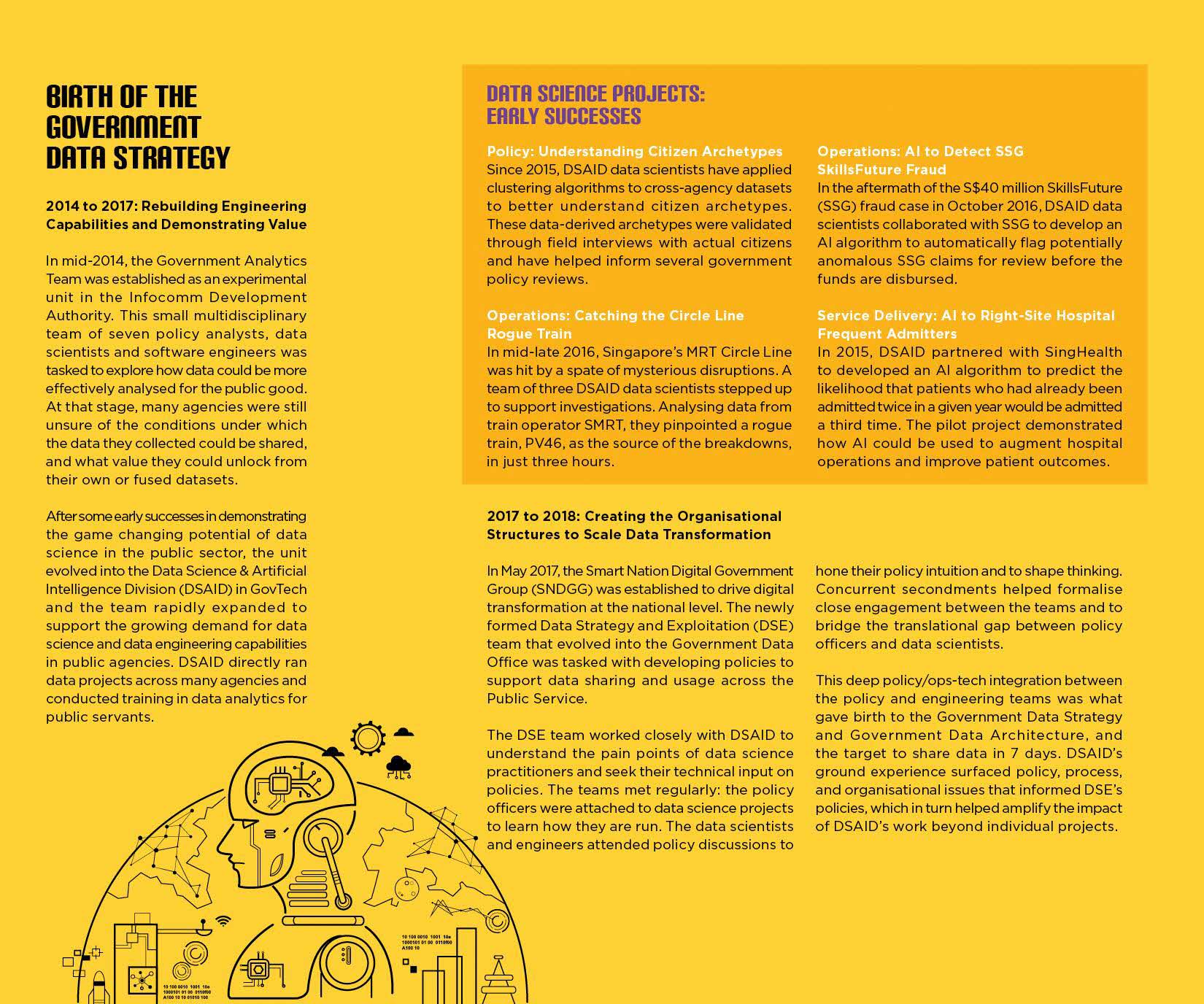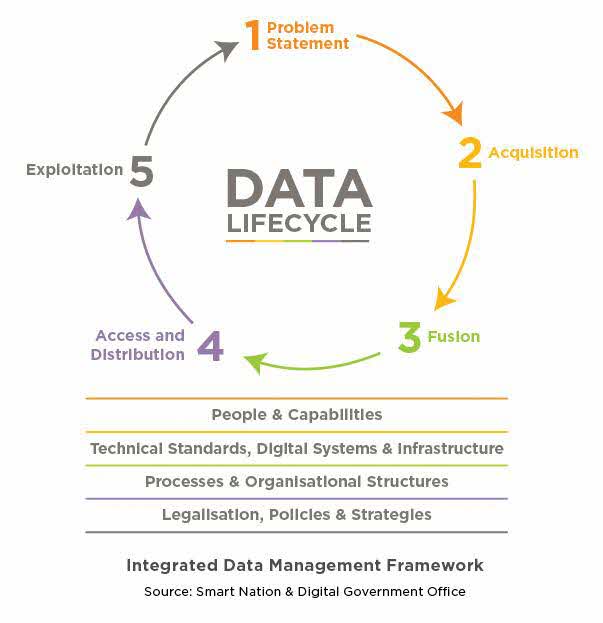Bringing Data into the Heart of Digital Government
ETHOS Issue 21, July 2019

Introduction: Why Digital Government?
Singapore has a unique opportunity to harness digital disruption—often characterised as the fourth industrial revolution—and propel ourselves onto a new growth trajectory to sustain our future national competitiveness and liveability. We must build strategic capabilities in data and digitalisation, which are the foundational infrastructure upon which Artificial Intelligence (AI) and other digital technologies are being developed and deployed.1 This is the broader strategic imperative for Smart Nation and why we are accelerating our collective effort to transform Singapore’s government, economy, and society.
Singapore’s Smart Nation aspirations hinge on Digital Government: the Singapore Government has traditionally set the agenda and pace for technology innovation and adoption across the nation. It has built the horizontal enablers that now sustain a vibrant technology ecosystem. In order to become a government that is “digital to the core”, the Singapore public sector must be able to harness data as a strategic asset.
Digital Government means purposefully organising the business model of government around data.
Data is the Heart of Digital Government
Digital Government must go beyond digitising processes and offering government services online. These are essential digital plumbing to raise productivity and bring convenience to citizens. But much more needs to be done to fully harness the game changing potential of digital technologies—to bring data into the heart of government.
Digital Government is about fundamentally rethinking how government will work and engage with citizens in a digital era, and re-engineering it to be more data-driven in all aspects: be it policy and planning, operations, service delivery, or citizen engagement. It means recognising that data is a strategic asset that underpins digital transformation, and purposefully organising the business model of government around data. Policies will be iteratively tweaked and calibrated based on data instead of trial and error; operational responses will be proactive and coordinated instead of reactive and fragmented; services will be more anticipatory and personalised instead of one-sized fits all.
Realising this vision of Digital Government requires bringing data and digitalisation together.2 Digitalisation is about using digital technologies to transform the way we work, and it gives us the infrastructure to strategically acquire and manage our data assets: the raw fuel that powers and sustains digital transformation. Data science and AI are tools that we can then apply to our data assets to further enrich their value and to improve digital infrastructure and services, which in turn generate more data that can be harnessed for digital transformation, thus creating a virtuous cycle.
If we can achieve this tight integration of data with digitalisation and mature as data-driven organisations, the future digital governmentwill be more user-centric and effective at delivering key outcomes.
• For citizens and businesses, this means engaging with a government that delivers end-to-end digital services on par with the leading digital companies, and communicates with a personal touch. They can expect more seamless and convenient options to transact with agencies, less red tape when resolving issues, and faster, more personalised and anticipatory services that address their pain points.
• For public officers, it means the opportunity to build a digital relationship with citizens that is anchored in a deeper understanding of their needs and aspirations. They will have ready access to data and information to better measure the effectiveness of policies and interventions. They will spend more time analysing and designing solutions to key challenges, instead of filling out paperwork. They will be able to coordinate with colleagues across different agencies and respond as One Government to solve complex problems, more effectively and at a lower cost than was previously possible.

For example, the Municipal Services Office (MSO) is leveraging data and digitalisation to transform the municipal feedback reporting process. Residents who encounter a municipal issue can snap a picture and submit their feedback on MSO’s OneService App. AI is applied to the data collected from the app (text, images, and geolocation) and the feedback is automatically routed to the relevant operational agencies. The data is also analysed to generate insights on municipal issue trends and hotspots, enabling agencies to proactively identify and resolve emerging issues. As a result, citizens experience a more seamless feedback and engagement process with One Government. Agencies have a better understanding of ground issues, spend less time re-routing cases among themselves, and are more efficient at resolving municipal concerns.
Further digitalisation will generate more data that can be harnessed to bring about greater improvements. Data collected from sensors and Internet-of-Things devices could be triangulated with municipal feedback to develop predictive maintenance models for infrastructure such as lifts. This will enable agencies to go upstream to address the root causes of municipal feedback, and for government and residents to co-create more liveable neighbourhoods for all.
This focus on data is what defines the Government’s current transformation drive, which will put in place the policies, processes, systems and people that will enable the public sector to systematically acquire, manage, and exploit data at an industrial scale.
Birth of the Government Data Strategy (2014 to 2018)
Our journey towards the Government Data Strategy (GDS) began in 2014 and is premised on three principles:
First, we plan and execute the GDS in an agile and iterative manner. Today, it is no longer possible to develop one-off masterplans that guide multi-year transformation efforts. Instead government must, as both a user and regulator of digital technologies, adopt a more experimental, iterative approach. We will learn and develop expertise by implementing data projects, and must be deliberate about distilling lessons and insights to inform subsequent iterations of the GDS and our data policies.
Second, we drive the public sector’s data transformation through a dual emphasis on implementing use cases in the short term and building institutional enablers in the long term. Use cases are data projects anchored on real problems—they enable agencies to gain hands-on experience with data. Delivering on quick wins can also help demonstrate the value of data and generate momentum for deeper transformation. In the long run, institutional enablers crystallise learnings from use cases and are what ensure sustained success.3
Third, we adopt a hub and spoke model to scale public sector data transformation efforts. We started by growing a central team at GovTech—the Data Science & Artificial Intelligence Division (DSAID)—to pool scarce engineering talent resources and quickly execute on use cases to demonstrate value to stakeholders. However, a central team would eventually be limited by its lack of domain understanding, and agencies must eventually own their own data transformation efforts. The central team is supporting agencies through forward-deployed teams; the Smart Nation and Digital Government Office (SNDGO) and GovTech are building centralised digital systems and infrastructure to offer scaled data capabilities.

Developing and Realising the Government Data Strategy (2018 to 2019)
Challenges for Scaling Data Use in Government
Data is the fuel for digital transformation. A good Government Data Architecture (GDA) should provide public officers with access to quality data, quickly and securely—just as good water infrastructure should make clean drinking water available on demand from a tap.
Singapore’s current GDA is based on the operating concept of “data sharing by default”: individual agencies are asked to share data with one another when a legitimate request is made.
In practice, however, it takes many months for cross-agency datasets to be fused and shared, despite the best intentions.4 Data sharing occurs through ad-hoc bilateral or multilateral arrangements, which have to be negotiated. Agencies collect data to serve their own needs, not cross-government uses. Many lack modern data systems for extracting and sharing data securely through Application Programming Interfaces (APIs). Nor is there a metadata catalogue or common data dictionary and format for government datasets. All this means that data users have to separately negotiate with source agencies to turn on the data tap. They then wait for several months for source agencies to manually extract the raw data, which needs to be cleaned and formatted to be fit for use. Our inability to share data quickly prevents data exploitation from scaling across the government.
Data is the fuel for digital transformation.
A New Government Data Strategy
In June 2018, the Government Data Strategy (GDS) was introduced to address issues with the current GDA. It is centred on the Public Sector reorganising itself around a new Integrated Data Management Framework (IDMF). The IDMF establishes a new operating concept for managing and using data across a 5-stage lifecycle: (1) Problem Statement, (2) Acquisition, (3) Fusion, (4) Access and Distribution and (5) Exploitation. It also identifies the horizontal enablers needed to manage data across its lifecycle. A Government Data Office (GDO) has been established to implement the GDS by 2023.

The GDS will be realised through four key thrusts: Data Architecture, Digital Infrastructure, Data Education, and Use Cases.
Data Architecture
We will build a new GDA to enable quick and secure access to quality data. Core government data assets will be consolidated, and made discoverable and accessible within 7 working days. All core data fields must also be machine readable and API-ready.
The new GDA introduces two new organisational constructs: Single Sources of Truth (SSOTs) and Trusted Centres (TCs).

SSOTs are authoritative sources for core government data fields. They are tasked with maintaining, cleaning, and distributing these data fields to requesting agencies within seven working days. For instance, there was previously no SSOT for family relationship data, which is a core government data field that many agencies require for policy analysis or service delivery. Agencies had to file separate requests to extract data from the marriage, divorce and birth registries, and manually construct the family relationship data field, a process that could take several months. Agencies used their own definitions which meant that data findings from different agencies’ projects were often not comparable. The Ministry of Social and Family Development has since been designated as the SSOT for family relationship data and is mandated to maintain and distribute it to the rest of the government.
TCs aggregate data across the SSOTs and provide a one-stop-shop for users to access core government datasets. Users who need cross-sectoral datasets will not need to go individually to each SSOT to ask for data. Three TCs, sited in the Department of Statistics (individuals and businesses), Singapore Land Authority (geospatial) and Smart Nation and Digital Government Group (sensors), will be operational from end 2019.
Digital Infrastructure
We will develop the infrastructure to digitally industrialise the management, governance, and use of data, to support and scale data transformation initiatives. The aim is to achieve a quantum leap in the speed at which data can be harnessed for insights and data models deployed into products and integrated into business processes.
Some examples of this infrastructure include: (a) Vault.Gov.SG, a platform that lets all officers browse a meta data-catalogue, securely download sample datasets immediately for exploratory analysis and then request full datasets from the TCs; (b) a code repository hosted on a common platform that enables data scientists to share their code with the public sector data community; (c) a whole-of-government analytics platform that enables the rapid development of data and AI models. Data security is built into these platforms by design.
Core government data assets will be discoverable and accessible within 7 days.
Data Education
We will raise data capabilities across different levels and equip all public officers with the knowledge and skills to bring data into their everyday work.
For the majority of public officers, the emphasis is on developing data literacy: the ability to scope data use cases to address business needs and use simple data visualisation and analytics tools. For officers whose job functions require them to work with data, the emphasis is on deepening technical skills, sharpening their ability to link analytics solutions to business needs, and developing the software and data engineering skills to translate analytics insights into products that are integrated into business processes.
Use Cases
We will partner with government agencies and companies to identify use cases and facilitate access to data needed to deliver them. Many agencies lack experience working with data and have grown accustomed to slow, tedious processes for data sharing. Organisational cultures and memories are sticky: there needs to be a central push to help kickstart the data transformation process and generate momentum.
To this end, DSAID has published a data science project scoping guide and runs workshops with the Civil Service College; the GDO has partnered with agencies to identify data projects under their Ministry Family Digitalisation Plans and is working with researchers and companies to facilitate data sharing; the Strategy Group in the Prime Minister’s Office works with agencies to commission data science projects.
From Government to Nationwide Data Transformation (2019 to 2023)
The GDO is working with the relevant agencies to operationalise the GDA and digital infrastructure in phases. The first tranche of SSOTs, the Individual & Business and Geospatial TCs, and Vault.Gov.SG will be operational from Q4 2019. We aim to improve the user experience of working with data, to encourage and empower public officers to use data in their work. The findings from the Public Sector Data Security Review will also be published end 2019 and incorporated into the GDA.
The Singapore Public Service has also made significant changes to organisational structures, placing data at the front and centre of agency digital transformation efforts. The GDO is developing a guide for agencies to develop and implement data strategies as part of their digitalisation efforts. It is also developing a new competency framework for Chief Data Officers (CDOs)—this professionalises the CDOs’ roles and mandates them to drive data transformation in their agencies. DSAID has developed a data science competency framework, supporting structured training for raising the data capabilities of public officers.
At the same time, we are also preparing for the future, to extend the use of data as a strategic asset at the national level and to systematically apply digital technologies such as AI to enrich the value of our data assets.5 SNDGO and the Infocomm Media Development Authority (IMDA) are jointly developing the National Data Strategy; SNDGO is also leading an inter-agency taskforce to develop Singapore’s National AI Strategy. Through engagements with agencies, companies, and researchers, an initial tranche of data science and AI use cases has already been identified to anchor these strategies.
Vault.Gov.SG was a ground-up effort initiated in June 2018 by a small group of software engineers from DSAID’s Open Government Products team and the GDO.
Creating Vault.Gov.SG
Vault.Gov.SG was a ground-up effort initiated in June 2018 by a small group of software engineers from DSAID’s Open Government Products team and the GDO. They were keen to operationalise the new GDA and put data into the hands of users, to demonstrate that it was possible to achieve data sharing in days and not months. Using an agile development approach, they launched a basic product for user testing within three months.
Working closely together as a cross-functional, inter-agency team, GDO and DSAID officers formed a strong bond. This contributed to a virtuous cycle: as policy considerations changed, the engineers were sensitive to new technical requirements and adapted quickly. For example, the team was able to pivot and prioritise the development of new data security features in response to recent data breaches. This “Policy-Ops-Tech” integration has allowed Vault.Gov.SG to gain traction across a broad spectrum of data engineers, users and security experts.
The entrepreneurial team worked on the MVP as a side project and pitched the idea to senior management before gaining additional resources to scale the MVP into a government-wide product
Public Service Is Entrepreneurship at the National Level
Over the past five years, Singapore has made progress towards our Smart Nation and Digital Government vision. The Public Service is now clearer about its transformation mission and what success would look like by 2023 (as reflected in the Digital Government Blueprint). We have built a core nucleus of in-house engineering talent to work with agencies, and are clearer about how Government needs to be reorganised to fully exploit the game-changing potential of data and digitalisation.
However, there is still a lot of work to be done. Many public officers still perceive their day-to-day work as removed from digital transformation. This sentiment will gradually change as our digitalisation efforts kick into full swing, and when technology becomes an integral part of public officers’ lived experience. The real drivers of change will be the groundswell of users and beneficiaries of data and digitalisation—we need to raise awareness and open minds to what is possible, by curating and publicising success stories. Enthusiastic users will be the ones demanding more; they will nudge their colleagues to deliver on digitalisation.
We must view public service as not just doing a prescribed job, but as engaging in entrepreneurship at the national level.
Transformation will require all public officers to take ownership and drive innovation from within their own agencies, starting with their own immediate sphere of work. This will require a fundamental shift in mindsets: we must view public service as not just doing a prescribed job, but as engaging in entrepreneurship at the national level. There are no prescribed templates for digital transformation. Public officers must be proactive about identifying problems that need solving, engage with users to understand their ground challenges, rally support and marshal resources for their ideas, and leverage the digital-ready machinery of government to implement them. Like entrepreneurs, they must be willing to roll up their sleeves and do whatever it takes to accomplish the mission.
Ultimately, transformation is about problem solving, which will have to be a process of learning by doing, building and leveraging expertise from across Government, and delivering through cross-functional teams. The solutions will be found not in “policy”, “operational”, or “engineering” fields, but in bringing these together and taking collective ownership over successes and failures. Public officers will have to be “makers”—creative, innovative, and entrepreneurial—in the truest sense of the word.
NOTES
- This will involve (a) raising our digital maturity to ingest, process, productionise, and integrate data into decision making and business processes, at scale, (b) building the ops-tech capabilities to develop new operating concepts and redesign systems, processes, and jobs to exploit AI and digital technologies, and (c) building robust institutions that are effective in managing and governing digital technologies.
- Adapted from Basis AI’s slide deck on “Artificial Intelligence: Explainability and Governance”.
- This is akin to focusing on performance and health in sport. Performance may enable a team to win the league cup in any given year, but health is what enables teams to dominate the sport over a decade.
- These figures were provided by DSAID based on their ground experience and were instrumental in shaping the Government Data Strategy.
- Despite Singapore’s small size, we are highly digitalised across the different sectors and have the ability to organise our national data assets. For example, we can leverage our unique common identifiers (e.g., National Registration Identity Card numbers for individuals, Unique Entity Numbers for businesses) to curate rich, cross-sectoral datasets.

